Another local story, this one dedicating a local square in the name of a USCT soldier. This article added an interesting point about slave names that I’d never considered before.
But when enlistment opened for men of color in Cape Girardeau, the Army wants you to have a first name and a last name. And in the course of the study that I’ve looked at, over 200 men who enlisted in Cape Girardeau, it was pretty typical that they, maybe by default, or you know just the pressure of the moment when they stood in front of the enlistment officer, they needed a first name and a last name. And so most of them chose the last name of their last enslaver.
Source: Remembering James Ivers: A Look Back On The Story Of A Slave-Turned-Soldier In The Civil War | KRCU

